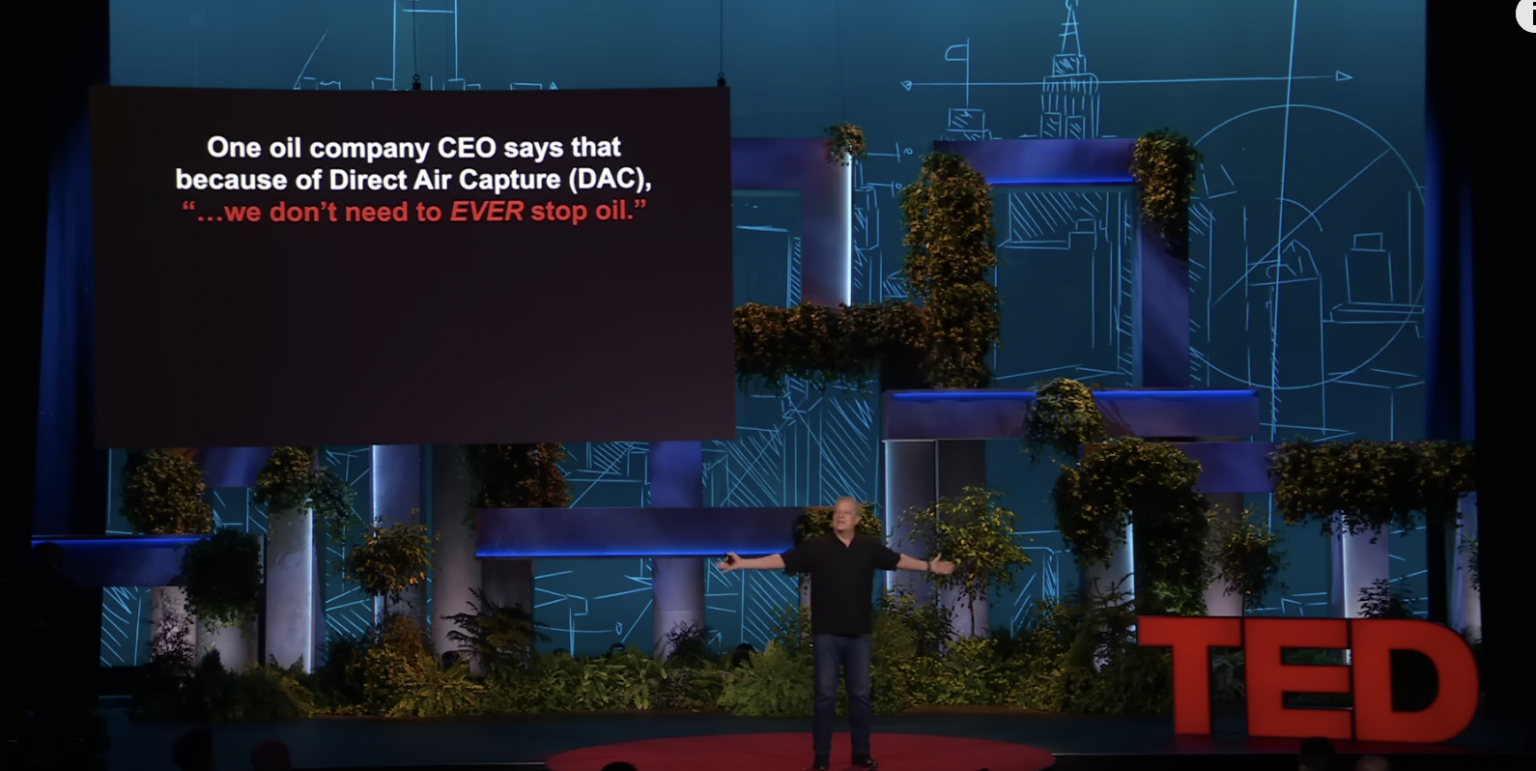The U.S. Department of Energy has announced that a subsidiary of U.S.-based oil company Occidental Petroleum will receive a grant to develop a commercial-scale direct air capture (DAC) facility in southern Texas.
It is one of two DAC projects selected under a $1.2 billion federal program to scale up DAC, which the Energy Department has called the “world’s largest investment in engineered carbon removal in history.”
This new DOE funding is part of a larger $3.5 billion allocation from Congress – under the Infrastructure Investment and Jobs Act, part of the Biden administration’s signature climate legislation – to develop four large-scale DAC hubs. But some critics contend that the federal government’s involvement in this new climate technology is giving fossil fuel companies cover, allowing them to create the impression that they are part of the transition to greener energy while they continue to focus most of their activities and money on their core oil and gas businesses.
Direct air capture is a nascent technology designed to capture carbon dioxide from the ambient air. In theory, it could help remove “legacy emissions,” or the carbon pollution that has already been emitted. Research and development projects to date have not yet shown how DAC can be scaled up to a global scale that would have an effect on slowing climate change.
Yet major polluters are already capitalizing on the conceptual promise of this technology to promote it as a climate solution.
“Oxy has said out loud that this is a ‘get out of jail free’ card, enabling the oil and gas industry to continue business as usual,” said researcher Kert Davies, director of special investigations with the Center for Climate Integrity, referring to Occidental Petroleum’s stock ticker symbol, “instead of heeding the urgent fossil fuel phaseout warning scientists have shouted in our faces for decades.”
Climate advocate and former Vice President Al Gore noted in a recent TED Talk that Occidental CEO Vicky Hollub has said that because of DAC, “we don’t need to ever stop oil,” and that the technology gives the fossil fuel industry “a license to continue to operate.”
According to Gore, “They’re using it in order to gaslight us, literally.”
Direct air capture may play a role someday, but the best option now is to halt carbon emissions in the first place, said John Fleming, senior scientist at the Center for Biological Diversity’s Climate Law Institute. “[Direct air capture] requires large amounts of energy, spurring more demand for the same fossil fuels that caused the climate crisis,” Fleming said.
Two of the four DAC hubs funded by the Department of Energy will be located on the Gulf Coast. In addition to Occidental’s hub in Kleberg County, Texas, a project proposed by Battelle, Climeworks, and other partners, called “Project Cypress,” will be constructed in Calcasieu Parish, Louisiana. On paper, the two projects together will have the capacity to remove two million metric tons of CO2 from the atmosphere per year. It is unclear exactly how much each project will receive in government funding, as they will be undergoing award negotiations.
DOE has not yet announced selection of the other two DAC hub projects. “We’re expecting in 2024 or soon thereafter that we will have another solicitation for additional hubs,” said Kelly Cummins, deputy director of DOE’s Office of Clean Energy Demonstrations.
Under the Inflation Reduction Act’s expanded tax credits for carbon capture technologies – a subsidy under section 45Q of the Internal Revenue Code for developers to capture CO2 from polluting facilities or from the atmosphere – qualifying DAC projects can receive $180 per ton of CO2 captured and stored, a significant increase from the previous credit of $50 per ton.
Occidental subsidiary 1PointFive, which focuses on developing carbon capture, utilization and storage (CCUS) and DAC projects, will be developing the South Texas DAC facility, according to DOE’s announcement. The company is currently building a smaller DAC facility in Ector County, Texas, in the Permian Basin, where Occidental continues to operate as one of the largest extractors of oil and gas.
Occidental has indicated that CO2 captured from its Permian Basin DAC plant could be used to drill for more oil through a process it has long used known as enhanced oil recovery (EOR). In its latest annual report, the company stated that its CO2 EOR operations “are critical to Occidental’s long-term strategy.”
However, according to DOE’s Cummins, this hub is not expected to be linked to enhanced oil recovery (EOR) operations.
A ‘Gimmick of the Fossil Fuel Industry’
Researchers who have analyzed the technical requirements of direct energy capture, such as energy load, warn that it is little more than a boondoggle. A 2020 analysis published in Nature Communications found that “the energy and materials requirements for [DAC] are unrealistic even when the most promising technologies are employed.”
In a 2019 study that examined the impacts of direct air capture, Mark Jacobson, a professor of civil and environmental engineering at Stanford University, found that it would increase CO2 emissions, air pollution, fossil mining and fossil infrastructure, largely because of the enormous amount of energy required to extract, compress, and separate the CO2.
Even if renewable energy is used to operate DAC, Jacobson told DeSmog that this would simply divert renewables away from directly replacing fossil fuels. At least for the next several decades or until fossil fuels are eliminated, “it is impossible for there to be a benefit of DAC, only an opportunity cost. It will only delay our solution to the climate problem,” Jacobson said.
“DAC is simply a gimmick of the fossil fuel industry to keep themselves operating and pretend they are doing something useful,” he added.
We really need to be smarter than this if we want to hold out any hope of solving global warming, air pollution, and energy security problems.
— Mark Z. Jacobson (@mzjacobson) August 11, 2023
People making decisions are leading us into the fire. https://t.co/TyoUKQ7kZi
In a statement, Occidental’s Hollub said the company looks forward to partnering with DOE to “deploy this vital carbon removal technology at climate-relevant scale.”
June Sekera, a climate researcher who has studied DAC, said that the feasibility of actually getting to that scale is “absurd,” and that DAC is meaningless from a climate change perspective.
Sekera, a research fellow at the Global Development and Environment Institute at Tufts University, told DeSmog that “the IPCC has said that DAC is going to be removing [essentially] zero CO2 by 2030.” The one commercial-scale DAC plant currently operating anywhere in the world, in Iceland, is designed to remove just 4,000 tons of CO2 a year, she said.
The IPCC, or Intergovernmental Panel on Climate Change, is the United Nations body that issues regular reports on the latest climate change science.
U.S. Secretary of Energy Jennifer Granholm told reporters on Thursday that if deployed at a commercial scale, DAC technology “can help us make serious headway on our net zero goals.” But climate and environmental justice advocates are largely opposed to the kinds of “carbon management” projects that fossil fuel interests are promoting, including direct air capture, and see them as a way for industrial polluters to continue operating as usual.
“We know that engineering-based removal activities are technologically and economically unproven, especially at scale, and pose unknown environmental and social risks,” said Marion Gee, co-executive director of Climate Justice Alliance.
Fenceline Watch, a Texas-based environmental justice organization, said in a statement that DOE’s funding of DAC hubs in Texas and Louisiana “represents, once again, the sacrifice of our communities along the Gulf Coast in the interest of the oil, gas, and petrochemical industry.”
Carbon180, an organization supporting carbon removal, told DeSmog that addressing environmental justice issues and not catering to polluters’ interests are key to building industrial-scale carbon removal in an equitable way. “We believe that the carbon removal industry can and should be built to redress the harms and injustices of the past. We’re keen to see DOE prioritize the interest of communities and not those of the fossil fuel industry,” said Sasha Stashwick, director of policy at Carbon180.
But Fenceline Watch contends that direct air capture further endangers communities already overburdened by industrial pollution.
“While the industry positions direct air capture facilities as a viable solution to removing carbon from the air, the reality is these hubs have never proven to be able to achieve these claims,” the organization said in an emailed statement. “This is a greenwashing campaign that will continue to put our communities’ health, environment, and safety at risk.”
Subscribe to our newsletter
Stay up to date with DeSmog news and alerts







